-
News & Trends -
Sales -
Marketing Related Topics -
B2B Software Guides Related Topics -
Free Tools & Resources -
- About Us About Us


SEO lead generation is the process of writing online articles relevant to your niche, then ranking them organically in Google and capturing readers' contact information using a lead magnet. Businesses that use SEO often focus on a three-fold strategy of website performance, a content plan, and earned links back to their website that increase visibility with their ideal customer. When done well, these efforts generate new leads to be further qualified and nurtured.
SEO is the act of optimizing your website and writing content that answers your target audience’s questions so you appear in Google for relevant keywords. Google crawls the internet and ranks content based on how well it answers a specific query or collective group of queries. This means that if you have good SEO, you’ll increase your visibility in relevant Google search results, and your ideal customer will have a higher chance of finding you.
There are three components of SEO — technical, on-page, and off-page:
SEO is effective and affordable, but it takes a long time to master, and search engines frequently change their algorithms and ranking parameters. If you want to try pay-per-click (PPC) ads for guaranteed placement at the top of relevant search results, read our article on PPC lead generation. Keep in mind, though, that PPC ads can be expensive and organic search results often receive more clicks than paid ads.
Typically, marketers identify questions their audience is asking via search queries, then give the best answers by writing informative articles that rank on a search engine results page (SERP) for related keywords, ultimately driving organic traffic to their website. Next, a valuable lead magnet captures visitors’ info, and the marketing team initially qualifies them. Marketing then often hands them off to sales, who continue qualifying and nurturing them through the sales pipeline to close.
The steps to generate leads via SEO are:
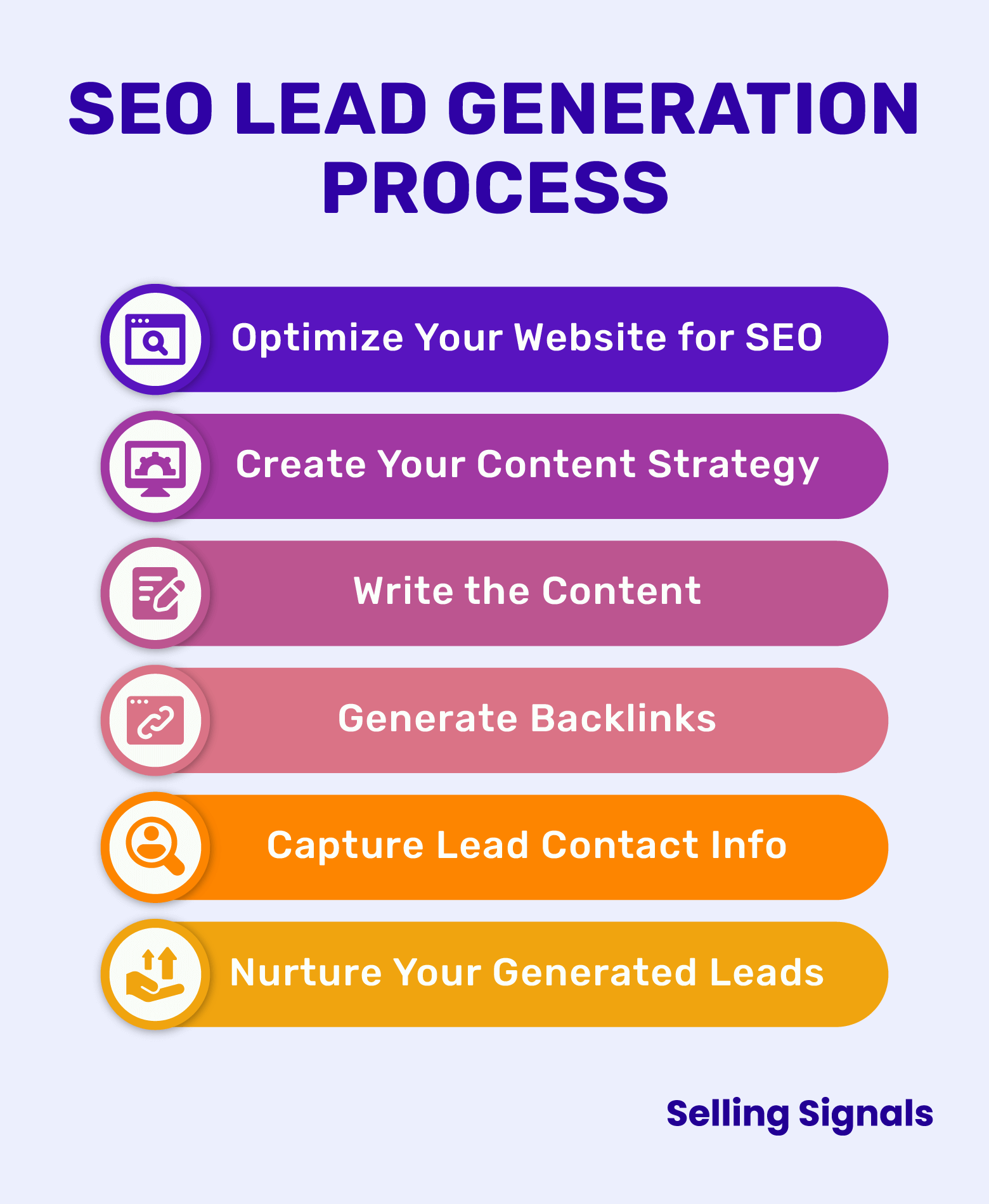
We’ll cover all six steps in this article and how to properly execute each one to see results. However, let’s first identify the businesses, teams, and individuals that can benefit from SEO lead generation to make sure the strategy is a good fit for your needs.
B2B and B2C companies can both benefit from generating online leads through SEO. If you have an online presence and want to initiate inbound lead generation, this is a solid way to generate highly relevant leads because you can target specific keywords relevant to your offering. However, ranking web pages organically in Google requires a lot of time, effort, and/or money. For this reason, it's not best for everyone.
More specifically, SEO lead generation is a great option for:
Posting high-quality, informative content will demonstrate your expertise in your industry and field.
Content created for SEO can be repurposed and used as part of a larger paid advertising campaign.
SEO content often has natural places for content upgrades you can offer your audience in return for their email.
Consumers who find you and opt in organically are often more likely to close than leads you pay for.
Couple your outbound lead gen efforts with an additional SEO strategy since buyers typically read multiple pieces of content before engaging with a seller.
If the above sounds like you, then SEO lead generation might be a good strategy to explore. Again, even though SEO is "free," it requires a lot of time and resources. If you don't want to manage your own SEO lead generation, jump down to our list of the top SEO agencies. Otherwise, check out the steps required to generate leads from SEO.
Enticing organic leads to provide their contact information starts with being highly visible to your target audience. Once you attract visitors to an optimized website through quality content, you can establish credibility, demonstrate value, and execute lead capture strategies. Below are the specific steps you can take to generate leads through great SEO.
There are two main ways to optimize your site for SEO: improve your user experience (UX) and speed, and correctly build out your site structure. These actions are part of technical SEO and will result in better visibility in search results and more traffic to your site. You can then start capturing contact information from the visitors to convert them into leads.
Websites with better UX and site speed typically rank higher in search results. Google measures UX according to Core Web Vitals, which are metrics that assess how fast your website’s initial content and largest elements on the page load, as well as the total loading time. All of these are part of Google’s overall ranking factors.
To measure these Core Web Vitals, Google offers a tool called PageSpeed Insights that lets you know how quickly your site runs and how usable it is. It tracks first contentful paint, largest contentful paint, speed index, and more. Then it gives you a score in each category, as well as an overall speed and usability score, shown below:
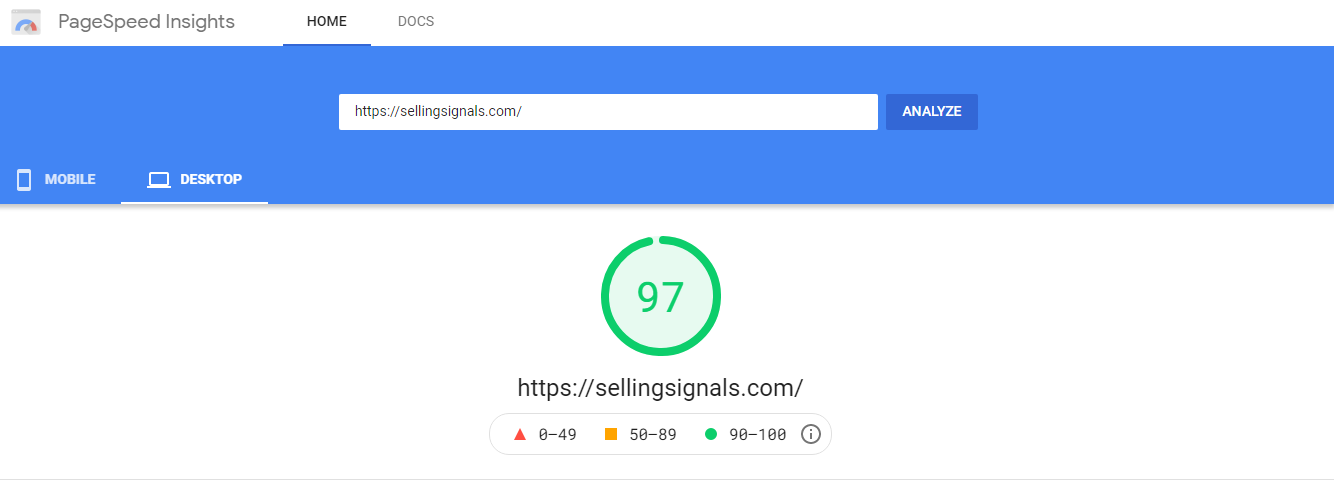
Let’s look at how to improve your speed and UX:
Ensuring your site is healthy and meeting Google’s speed metrics directly translates into how and where they suggest it to potential customers. Keeping your site’s visitors experience top of mind is vital when looking to use SEO lead generation.
Website structure also affects UX and Google’s ability to crawl your site. To make sure your site and content are easy for Google to understand, define the site’s primary categories and then choose the detailed subcategories underneath them.
Consider the following when creating your categories and subcategories:
These categories and subcategories will also make it easier for your website visitors to navigate your site and read your content. Once you improve your site’s UX and speed and you plan out the structure and generally how your content will fit into it, you can get started on creating a content strategy that uses your categories and subcategories as a foundation.
To learn more about how to create and optimize a website for lead generation, check out our article on creating a lead generation website. There, you'll find detailed processes on how to build and optimize one for your needs.
Your content strategy is how you improve your on-page SEO, and it should incorporate target customer research, relevant keywords, and thought-out topic clusters, which are groups of articles that relate to each other and support a broader topic through interlinking. As you plan your strategy, remember that the key is to identify the questions that are being asked and answer them for your intended audience.
Decide who your ideal customers are, as well as what they need and want. When you understand what they care about, the problems they have, and the solutions they’re seeking, you can create the best content to help them find and connect with you.
Here are a few common techniques to research your target audience:
To get the best picture of who you’re targeting, try all three of the methods above using your current and ideal customers. When you know your intended audience well, you can anticipate the questions they’ll ask and help answer them.
The keywords (words, terms, or phrases) that people use in their Google searches give critical insight into their questions and motivations. To identify the keywords you should be targeting with articles, choose your topic areas and figure out the primary questions people are asking about them, then shorten those questions to relevant keywords.
Hone in on the following concepts in order:
By following the steps above, you can find out what your target audience is entering into search engines and why so you can incorporate the best keywords into your content strategy.
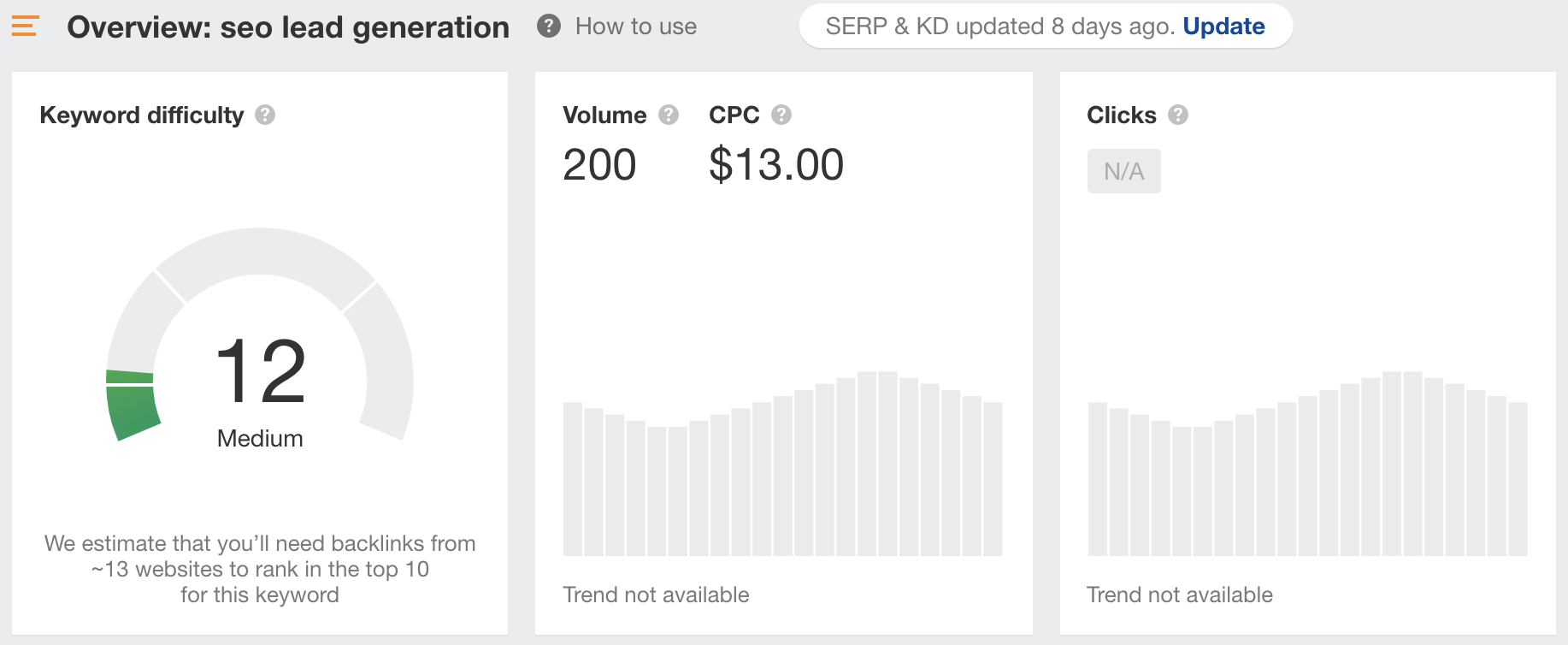
After you've found your keywords based on the questions your audience is asking, it's time to organize your topic clusters by identifying your high-level keyword topics plus the related keywords that will cover the more specialized subtopics within them. The topic and subtopics in a cluster work together to provide comprehensive information about a subject, which in turn improves a site’s SEO and UX.
Create a topic cluster by looking at your list of keywords and figuring out how they relate to one another. Then organize those interrelated topics into a cluster map using the following:
With your cluster map created, connect the articles in the cluster using internal links. Your normal content should link to both the subpillar and pillar it sits beneath, as well as to all closely related normal content. Every subpillar should also link back to its pillar. This map from HubSpot shows an example of this interlinking between articles:
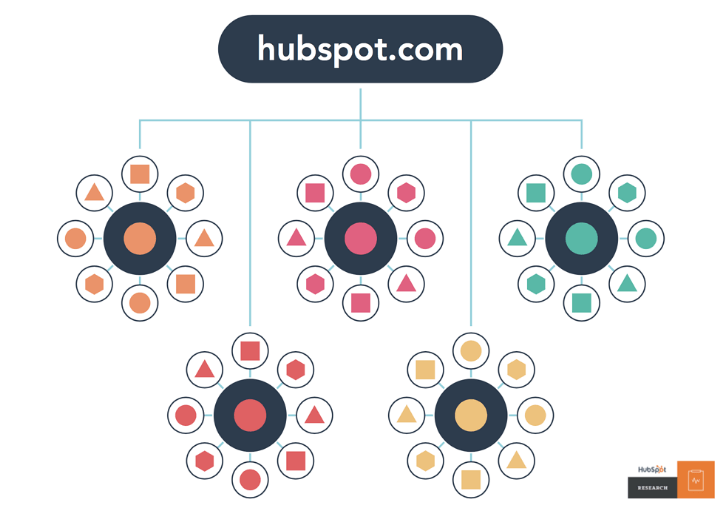
When you’ve planned out your clusters, create a posting schedule that’s realistic for your business and prioritizes consistency. You can then start writing new articles and optimizing existing articles. Plan to write the most specific content in each content cluster first and the broadest content last to build the cluster from the ground up. Depending on the amount of content you have, decide on your publishing frequency, such as one new article per day or week.
Let's say you've created a cluster with one pillar, three subpillars, and three normal content articles within each subpillar. Build a content calendar that prompts you to publish the nine normal articles first, then the three subpillars, then the pillar article. The pillar page will serve as a directory to your more specific articles, and you'll avoid writing duplicate content on multiple pages.
With your content strategy in mind, you’re now ready to write new content. This is also the time to identify existing content that fits into your topic clusters and optimize it with the same strategy. If you create quality articles, you’ll reap the benefits later on in your SEO sales funnel, so take the time to do these well and make sure they accurately answer the question. Consider hiring expert writers on Upwork or another freelancing platform to help you write the best content possible.
To start writing new content, take a look at the list of content you decided to write when you planned your content runway. Then follow these steps to draft the outline for your first article, write the full text, and add the finishing touches:
Your new content should complement any existing content you plan to update. We'll look at this existing content next.
If you’ve already written content that's relevant to your new content strategy and will be beneficial to your SEO and the visitors it brings in, take the necessary actions to be able to use that content. Follow the key steps you took when creating new content to also refresh, update, and add to your existing content so it follows your new strategy, and examine the existing content using a few guiding questions to make sure it's serving the right purpose.
To make sure you properly optimize your existing articles, ask yourself questions about the below:
The new content you’re writing will need to be continually optimized too, so make asking these questions a common practice. When you’ve written and optimized your quality articles, you can start sharing them with your audience through your own site and backlinks on other sites.
When writing your content, a good approach is to write the most niche-specific articles first, working backward from more detailed topics to the broader topics at the top of your cluster. This way, you can improve your own expertise about the topic from the ground up and ensure broader pieces of content are supported by more detailed answers.
Backlinks are links to your website that show up on other sites. They’re an effective off-page SEO tool to help you rank in searches. Backlinks from authoritative, high-ranking sites will give you better results than those from lower-ranking sites. There are two types of backlinks: passive and active. As your website and content start ranking and readers discover and share your articles, you'll naturally build passive links; however, you'll still want to request backlinks.
There are many tactics to actively earn or build valuable backlinks. A few to try are below:
Moz wrote a beginner’s guide to link building that provides more information on how backlinks work to benefit your business. If you’re new to backlinks, reading the guide will give you a solid foundation so you can start generating them. While we recommend trying to build links yourself, you can also consider enlisting help from a link building agency, as long as you properly vet them.
After you complete the steps above, you should start to see traffic. Next, collect contact information from visitors so you can add them to your pipeline and start to build relationships. Optimize your website for lead capture and make sure the form works well on both desktop and mobile. Then create lead magnets relevant to the articles that are organically ranking the best on Google, offer your lead magnet within those articles, and encourage visitors to supply their info.
A lead magnet, or content upgrade, is free content that you make available to your target audience in exchange for their contact information. The objective is to create content that is so valuable to your leads that they voluntarily opt in so they can receive access to it.
A few examples of effective lead magnets include checklists, cheat sheets, templates, ebooks, webinars, free trials or discounts, and more. Below is an example of a checklist lead magnet:
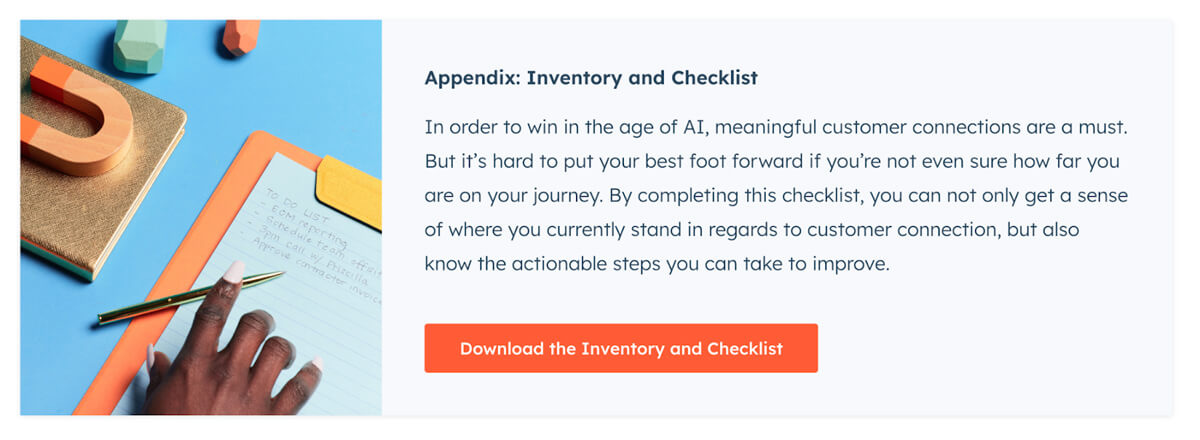
The type of lead magnet you choose for SEO lead generation should depend on your chosen topic area and ideal customer, plus the high-ranking article to which you'll add the lead magnet.
To learn more about lead magnets, check out our article on how to create a lead magnet that converts. In the article, you'll see how lead magnets work, the steps to make one that your ideal customer will find valuable, and examples of different kinds of magnets.
Landing page builders are one of the specific ways to offer lead magnets to your visitors. They enable you to create single web pages that can capture leads or facilitate online transactions. When you add a lead magnet to the successful article you've identified, you can link it to a specific landing page so that when a reader clicks the lead magnet, they're taken to the page.
Here are a few quality landing page builders that can help you create these pages:
When you design a landing page, double-check that it delivers on its promises so you can gain your visitors’ trust. For example, if you tell the reader to click a lead magnet to receive it and then you bring them to a landing page, make sure the magnet is easy to retrieve on the page.
We’ve written an article on the best landing page builders according to cost, general and advanced features, and our expert score. Take a look and choose the one you believe will best serve your business.
Lead capture software refers to tools, utilities, and apps that collect lead contact information online. It can prompt visitors to hand you their information when they sign up to receive a lead magnet or when they request a call or email from your sales team, register an account, or make a purchase. This software commonly includes pop-up or embedded forms on websites.
Some of the best lead capture software options available are:
When you add your lead magnet to the successful article you've chosen, set up the lead capture form to pop up when a reader clicks the magnet, or add the form to a landing page and link the magnet to the page. The benefit of connecting the form directly to the lead magnet is that it's a quicker process for the lead, but taking them to a form on a landing page can communicate more info to them — for each article and lead magnet you create, choose the right option for you.
In addition to the above, there are several factors to consider when choosing which lead capture software to use. We’ve put together a guide to help you choose the right software for your sales process.
When you add a chat function to your website, you can use it to support new visitors to the site and even send relevant lead magnets to them via chat. You can set a chat box to pop up, or it can be an option on your “contact us” page.
Chat boxes can benefit your lead generation process and support you to:
If you add a web chat tool to your site, look for one that works well for the type of business you’re in and can integrate with your preferred CRM platform. If you use a CRM or plan to in the future, connecting it to chat means you’ll be able to easily track and organize your newly generated leads.
For detailed information on live chat for sales and service, check out our article on the best live chat software options available to learn more about their features and how to choose your chat software.
Well-crafted CTAs further encourage leads to trade their contact information for something of value to them. When you offer a lead magnet or another tool to capture information, be sure you’re effectively using CTAs to convince your visitors to accept the added value.
Follow these best practices for calling your visitors to action:
The example below includes a CTA for the site visitor to RSVP for a company sponsored webinar:

Lead magnets paired with landing page builders, landing page software, online chat capability, and CTAs will help you capture your leads’ contact information. Your next move should be to promptly reach out to them so you can start to build relationships while you’re top of mind.
As soon as you’ve generated leads from your content and collected their information through lead magnets, it’s time to nurture them through qualification, direct contact, and follow-ups. The goal is to move them through your sales pipeline to close. Let's look at each step to nurture them.
Compare the leads you’ve generated to your target customer. How closely do they match the key information you found when researching your existing and ideal clients? If there seems to be a fit based on your lead qualification threshold, reach out to establish a relationship.
Use personalized emails and/or a discovery call to get in touch with your qualified leads (aka prospects). During your discussion, confirm that there’s a fit, learn about the pain point(s) they’re trying to solve, and gauge their interest to convert them into a prospect.
Follow up a specific number of times over a specific period of time (e.g., three times over a total of three weeks). Continually remind them that you understand their pain points and are available to help if and when they need you or your product or service. Aim to overcome your prospects’ objections and meet their needs so you can make the sale.
For more on how to move your generated leads through your pipeline, see our article on lead nurturing, where you'll learn the steps to get your new leads closer to becoming customers.
Generating leads through organic traffic is time-consuming, but there are SEO agencies that can support you. The top SEO lead generation services help their clients optimize their website (technical SEO), plan their content (on-page SEO), and build links (off-page SEO). These are a few agencies to consider hiring if you want to outsource this part of your lead gen strategy:
While link building agencies can be helpful, it's sometimes safer to go with an SEO or digital marketing agency like these so they can help you with all aspects of your SEO strategy, not just off-page. Any of the options above would be a good choice, so check them out to see if they offer what your business is looking for as you work to find new leads.
SEO lead generation is a skill you can learn by following the concrete steps we've laid out, but since it's a complex strategy, practicing it and tweaking your methods is necessary to master it. Check out these top seven best practices to keep in mind as you get started generating leads through SEO:
Many of your readers will likely view your articles on their phones, so Google will reward you for optimizing your site for mobile, and your visitors will enjoy their experience and be more likely to return.
To help Google rank your article and to encourage readers to click on it, write unique metas that include your keyword, a CTA, and the value they'll receive, and keep them under 150 characters.
Create a schedule to regularly search your own website on Ahrefs and fix any broken links you find.
Keep your content different, as duplicate content can confuse Google and force it to choose which identical text to rank; this can impact both pages' ability to rank.
Rather than keyword stuffing your articles in an attempt to rank in Google, prioritize your readers' experience and stick to a 1–2% keyword density to keep the text sounding natural.
Whenever it makes sense to do so, link to other articles on your site and to quality outside articles; this will help provide the full answer to your readers' questions and help Google crawl your site.
To increase traffic to your website and improve your domain authority, optimize your blog for SEO. This will help Google crawl your articles and make it easier for your visitors to find, read, and share them.
As you become more familiar with SEO, including using it to get more traffic to your site and collect visitors' information, you'll naturally discover what works well for your business. Keep track of the lessons you learn, follow the tips above, and continue learning new best practices and strategies, and you'll gain SEO lead generation expertise.
SEO lead generation is a tried-and-true way to answer your potential customers’ questions, attract them to your site, collect their contact information, and start moving them through your sales funnel. If you properly implement SEO lead generation, you’ll start to see the specific benefits below:
As you publish high-quality, relevant content that benefits your target customers, you’ll gain their trust and they’ll see you as an expert in your field.
Being more visible than your competitors will help your audience find you first. From there, you can provide value to earn their loyalty.
Because SEO is organic, generating leads through SEO is cost-efficient compared to other marketing methods.
As more people discover you through your SEO, and as you post your new content and lead magnets to platforms like social media, you’ll become more visible to your audience on Google and other sites.
If you want good SEO, you need good UX so Google and your visitors can understand your website. Therefore, pursuing SEO lead generation forces you to take a hard look at your site and make improvements to its speed and structure.
Not all leads that visit your site and opt in will become prospects, but they will be more likely to convert than those who neither know your business well nor voluntarily hand you their contact information.
While PPC advertising gives you a temporary spot at the top of the Google SERP, your SEO lead generation efforts will help you build your brand, scale your business, and improve your visibility for as long as you continue those efforts.
Even if you don’t experience all of these benefits, achieving even a couple should affirm to you that SEO lead generation is a valuable way to spend your time and resources. SEO is a long game — you’ll reap the benefits in a more substantial way in time.
SEO lead generation is a vital component of a successful sales strategy. To capture leads that convert, first organize your website; next, plan, write, and organically rank your articles; then get yourself seen by your target audience; and finally collect their contact information so you can build relationships. If you prioritize consistency and patience, you’ll produce lasting results. Now that you’re targeting new SEO leads, check out our article on how to qualify them.
This article was written by Meghan Lafferty and updated by Allyssa Haygood-Taylor.


Meghan has been the editor of Selling Signals since early 2021, writing and editing informative articles for B2B sales professionals and growing the website's content and authority. Before joining the site, she studied communication and English at the University of Illinois at Urbana-Champaign, then started her career at a healthcare trade publication and multiple nonprofit organizations. In her free time, Meghan enjoys traveling, reading classic novels, and spending time with her husband and their dog, Wrigley.

Selling Signals delivers actionable advice for sales and marketing professionals. Learn strategies that help you hit targets, strengthen customer relationships, and win more business. Get expert advice on lead generation, sales processes, CRM software, sales management, and account management directly to your inbox.
Property of TechnologyAdvice. © 2025 TechnologyAdvice. All Rights Reserved
Advertiser Disclosure: Some of the products that appear on this site are from companies from which TechnologyAdvice receives compensation. This compensation may impact how and where products appear on this site including, for example, the order in which they appear. TechnologyAdvice does not include all companies or all types of products available in the marketplace.